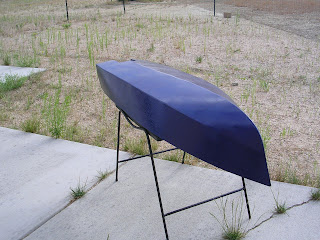


Early runabouts were built on the warped-plane shaped, semi-planing hull bottom. This is the form that interests me most. I am not interested in the high horsepower, blasting through the water experience, but would rather glide smoothly, quietly, at moderate, breeze-creating speed and with good fuel efficiency. Achieving a smoothly transitioning warped plane hull bottom is also more interesting for me to design than a constant deadrise planing hull would be.
I built a series of three models in developing the current design. This design method does not use a drafting table or a computer program/screen to create the hull. The hull is shaped by the use of mathematical equations and geometric projections of calculated (x,y,z) coordinates until an entire table of dimensions to define all surfaces and/or intersections is created. The hull only becomes visible as the coordinates are plotted in a connect-the-dots fashion. Similarly, the entire boat is created by plotting the dimensions of each piece (coordinates of many points) to produce a pattern for each part, model or full size. Many dimensions are mathematically exact; the remainder are accurate within about 1/32". The "connect the dots" dimensions are closely spaced so that a short 2-3 batten can be used when connecting them for a full size pattern.
Mathematically almost any shape can be defined. In the real world each piece needs to be cut, bent or laminated to create the actual shape. Thus, I always try to design the final form using long, gentle curves rather than abrupt bends which are difficult to achieve during actual construction.
0 komentar:
Posting Komentar